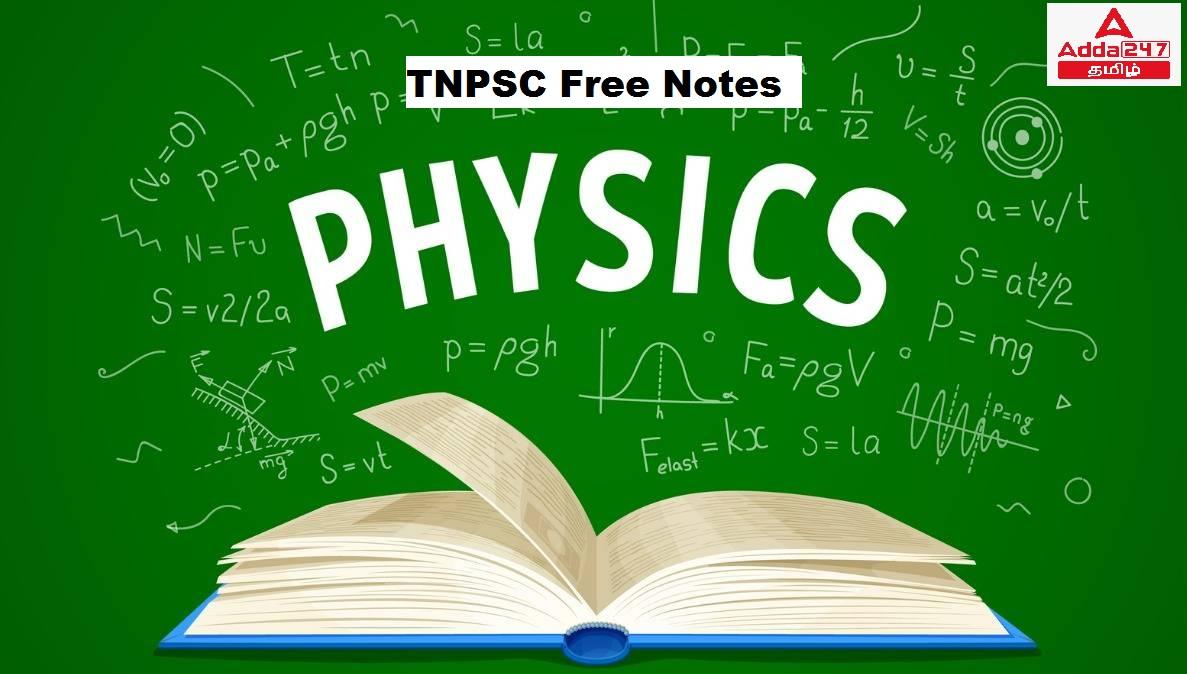இந்தக் கட்டுரையில், TNPSC குரூப் 1, குரூப் 2, குரூப் 2A, குரூப் 4 மாநிலப் போட்டித் தேர்வுகளான TNUSRB, TRB, TET, TNEB போன்றவற்றுக்கான முறைகள் இலவசக் குறிப்புகளைப் பெறுவீர்கள்.தேர்வுக்கு தயாராவோர் இங்குள்ள பாடக்குறிப்புகளை படித்து பயன்பெற வாழ்த்துகிறோம்.
Motion and its types
Mechanics is one of the oldest branches of physics. It deals with the study of particles or
bodies when they are at rest or in motion.
Mechanics can be divided into statics and dynamics.
Statics is the study of objects at rest; this requires the idea of forces in equilibrium.
Dynamics is the study of moving objects. It comes from the Greek word dynamis which
means power.
Dynamics is further subdivided into kinematics and kinetics.
Kinematics is the study of the relationship between displacement, velocity, acceleration
and time of a given motion, without considering the forces that cause the motion.
Kinetics deals with the relationship between the motion of bodies and forces acting on
them.
Motion:
Motion is the change in the position of an object with respect to its surrounding.
Types of motion:
I) based on Axis:
Motion in one dimension:
One dimensional motion is the motion of a particle moving along a straight line.
This motion is sometimes known as rectilinear or linear motion.
An ant moving in a straight line and running athlete.
Motion in two dimensions:
If a particle is moving along a curved path in a plane, then it is said to be in two
dimensional motion.
A body moving in a plane.
Motion in three dimension:
A particle moving in usual three dimensional space has three dimensional motion.
Motion of a flying bird
Motion of a kite in the sky
II) Based on direction:
Linear motion:
An object is said to be in linear motion if it moves in a straight line.
A particle falling vertically downwards to the Earth.
Circular motion:
Circular motion is defined as a motion described by an object traversing a circular path.
The whirling motion of a stone attached to a string
Oscillatory motion:
If an object or particle executes a to–and– fro motion about a fixed point, it is said to be
in vibratory motion. This is sometimes also called oscillatory motion.
Vibration of a string on a guitar
Random motion:
Movement of an object in random manner.
Movement of particles in colloidal solution.
iii) Based on distance and time:
Uniform motion:
An object is said to be in uniform motion if it covers equal distances in equal intervals of time.
Non uniform motion:
An object is said to be in Non uniform motion if it covers unequal distances in equal intervals
of time.
Projectile Motion:
A body thrown with some initial velocity and then allowed to move under the action of gravity
alone, is known as a projectile.If we observe the path of the projectile, we find that the projectile
moves in a path, which can be considered as a part of parabola. Such a motion is known as
projectile motion.
Angle of projection:
The angle between the initial direction of projection and the horizontaldirection through the point
of projection is called the angle of projection.
Velocity of projection:
The velocity with which the body is projected is known as velocity of projection.
Range:
Range of a projectile is the horizontal distance between the point ofprojection and the point
where the projectile hits the ground.
Trajectory:
The path described by the projectile is called the trajectory.
Time of flight:
Time of flight is the total time taken by the projectile from the Instant of projection till it strikes
the ground.
Examples:
a bomb thrown from an aero plane
a javelin or a shot-put thrown by an athlete
Motion of a ball hit by a cricket bat etc.
**************************************************************************
| Adda247 TamilNadu Home page | Click here |
| Official Website=Adda247 | Click here |




